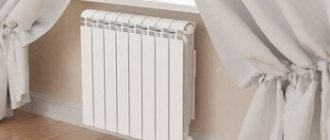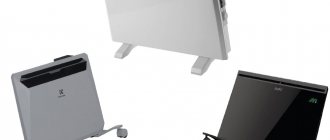Today, bimetallic radiators are recognized as the best for water heating systems, which combine aluminum And steel, accordingly, have the advantages of two metals. In terms of power, they are not inferior to aluminum or steel radiators, and in terms of wear resistance - to cast iron ones. We bring to your attention a rating of the best bimetallic radiators for a private home, apartment and office.
| Model | Price per section |
| 1.ATM THERMO 500 | from 520 rub. |
| 2. Fondital Alustal 500/100 | from 450 rub. |
| 3. Global STYLE PLUS 500 | from 1200 rub. |
| 4.ROMMER Profi BM 500 | from 480 rub. |
| 5. ROYAL THERMO VITTORIA 500 | from 1240 rub. |
Mini rating
Bimetallic radiator - general information
The most practical choice for rooms of different sizes and purposes is bimetallic radiators. The devices are constructed of steel and aluminum. The radiator has high heat transfer, while being resistant to corrosion processes, reliable and practical.
Bimetallic radiator has the advantages of two metals
The following types of bimetallic radiators are distinguished:
full bimetallic - produced using the casting method, the advantage of the design is that the likelihood of metal contact with the coolant is eliminated, withstands heating up to +130 degrees , pressure up to 35 bar ;
part-bimetallic - in the design of a steel exclusively water-conducting channel, the issue of excess pressure is thus resolved, but the threat of the spread of corrosion remains.
Advantages:
- strength;
- versatility;
- high heat transfer;
- simple installation;
- exact parameters;
- the design is not hazardous;
- it is possible to install the valves necessary to control the temperature;
- long period of operation.
Pay attention to the material the tubes are made of - they must be steel
Advantages of bimetal
The popularity of modern bimetal radiators is not accidental. They are distinguished by a set of unique properties and advantages.
- The thoughtful design of the case is created for maximum heat transfer and free air circulation based on the principle of convection.
- Radiators are assembled from sections, which makes it easy to extend or shorten them depending on the needs of the homeowners.
- Monolithic structures are characterized by the highest resistance to water hammer, complete elimination of leaks and a service life of up to 100 years.
- Bimetal batteries have an attractive design, are available in a variety of colors and are coated with a two-layer paint composition that is protected from damage and fading.
- The aluminum body heats up quickly and cools down just as quickly, which makes it possible to fine-tune the temperature using the regulator.
- The steel or copper collector of bimetallic radiators is able to constantly withstand chemically active coolant.
Note! To prevent corrosion, it is necessary to bleed the air regularly to prevent prolonged contact of oxygen with the inside of the device.
- The devices demonstrate high resistance to heat and can withstand even 130 °C.
- A well-thought-out connection system makes installation very simple.
What you need to know about the types of bimetallic batteries
At first glance, bimetallic radiators seem the same, but these designs are classified according to different criteria.
Bimetallic and semi-bimetallic
In bimetallic structures, the outer casing is made of aluminum, and stainless steel and copper are used for the convector core.
In accordance with the technology, a sealed product of high strength is obtained, with maximum protection against leaks. In semi-bimetallic models, the internal frame is made of several metals - stainless steel, aluminum. This design is less durable than a bimetallic one; corrosion processes and leaks are likely.
Artyom Ivanov
Plumber, author of the channel “Good-natured Plumber”
Externally, bimetallic and semi-bimetallic radiators are practically the same. To understand which radiator is in front of you, pay attention to its lower part. For a semi-bimetallic one, there will be specific oval plugs located there. But a completely bimetallic one does not have this.
Sectional radiators
Each section is attached using nipples, thus forming a radiator of the required power.
Pipe sections located horizontally have multi-directional threads. Stacked designs are practical; they allow you to adjust the power by adding or subtracting sections. Such designs also have disadvantages First of all, these are joints; the permissible operating pressure readings are limited.
A significant drawback of stacked radiators is that coolant gets on the aluminum in the event of a leak, resulting in corrosion, and the structure requires replacement faster.
Monolithic radiators
Solid, cast batteries do not have the disadvantages of stacked structures; they are designed for pressures of up to 100 atmospheres , but there is no ability to regulate the power and the price of such structures is on average 30% higher . The main area of use is high-rise buildings where there is high pressure in the heating system.
No. 3 – ROMMER Optima Bm 500 x12
Price: 4,300 rubles
A new model from a well-known company. It has a sufficient power reserve, which allows it to reach a maximum operating temperature of 110 degrees. Another advantage is the unique RAL 9016 painting system using the cataphoresis method. In simple terms, due to it the coating is much less prone to damage. The collector is made entirely of metal, which also speaks in favor of durability.
The unit is suitable for heating rooms up to 20 square meters. In addition, it has an attractive appearance, due to which it will organically fit into the interior of any room. Among the disadvantages are difficulties during installation; it is difficult to cope with it yourself; you will have to call a specialist.
ROMMER Optima Bm 500 x12
Which radiators are better
1. Cast iron radiators.
Modern cast iron batteries look much more attractive, more compact and elegant in comparison with outdated, Soviet models.
Advantages - durability, resistance to corrosion processes.
Disadvantages : heavy weight, slow heating.
Important! The main cause of failure is clogging with sediment. It is recommended to soften the water or use antifreeze.
2. Aluminum radiators.
They have high heat transfer, are lightweight, quite attractive, and are easy and quick to install. There are assembled structures of 10 sections , or select the required number of sections yourself.
Advantages : aluminum heats up and cools down quickly, affordable price, compatibility with different heating systems.
If we talk about the disadvantages - it cannot be used in systems where it is difficult to control the coolant; aluminum is not compatible with noble metals.
Important! Plastic pipes are used with aluminum batteries, and grounding is also organized.
3. Steel, panel radiators.
This option is most popular for installation in cottages, but steel batteries are not suitable for multi-storey buildings due to the low operating pressure.
Steel radiators have a fairly long service life, are easy to install, have different mounting options, and offer a wide range of radiator sizes.
The main disadvantage is susceptibility to corrosive processes.
4. Bimetallic radiators.
An optimized, improved analogue of aluminum batteries with one difference - a steel distribution tube is installed inside. The design can withstand pressures of more than 35 atmospheres .
Bimetal does not have many disadvantages
Artyom Ivanov
Plumber, author of the channel “Good-natured Plumber”
Before buying a radiator, be sure to find out the level of acid-base balance of the coolant in the house. If the pH is between 7 and 8.5, then an aluminum radiator must be installed in the system. And if the pH is in the range from 7 to 9.5, then choose bimetallic. Only after this can you begin to select a manufacturer.
No. 8 – Royal Thermo BiLiner 500
Price: 660 rubles
One of the most affordable models in the range of a popular manufacturer in Russia. Owners praise it for its ease of installation - you can figure it out yourself, saving on calling a technician. The main trump card of the model is that its collector is made entirely of metal, which is extremely cool considering how much it costs.
The brand backs up its confidence in the reliability of its product with a 25-year guarantee. The design is unique in that dust does not accumulate on it. Therefore, it is extremely easy to care for - you just need to wipe it with a cloth from time to time. In reviews, owners complain about this radiator because it only has good paint on the front side. On the sides, the quality of the coating leaves much to be desired.
Royal Thermo BiLiner 500
The best companies of bimetallic radiators
Royal Thermo . A domestic brand that produces products that meet European standards using equipment from Switzerland , Italy , and Spain . The quality of each stage of production is strictly controlled.
ATM . Another domestic brand that produces high-quality and at the same time inexpensive heating radiators for apartments. Domestic raw materials are used, coloring is carried out using the complete immersion method. Users note the attractive, laconic design.
Global . An Italian manufacturer that offers on the domestic market radiators that are fully adapted to the local climate and operating conditions. Aluminum alloys used in aircraft construction and the automotive industry are used. Operation period 25 years .
Sira . The achievements of the Italian brand in the field of bimetallic heating devices are confirmed by patents. The brand's products are rightfully considered the standard of quality and reliability.
Rifar . The Russian brand specializes in the production of bimetallic radiators adapted to the Russian climate. The workshops are equipped with modern equipment.
Fondital radiators also received good reviews .
Let's sum it up
In addition to the brands presented above, you can find products from other manufacturers on sale. But you should never purchase radiators based on their cheapness, no matter how attractive the cost may seem. It is unlikely that they will be of high quality, which means they can fail at any time.
In conclusion, I would like to say that you should not rely too much on reviews posted on the Internet by users living in other regions of the country, since operating conditions may differ significantly from each other. Heating networks may have different pressures and temperatures of the coolant, and it also happens that these parameters may be different even in neighboring houses.
The best option would be to purchase high-quality heating devices from a well-known manufacturer in specialized stores, and you should not save on them. In this case, it is necessary to request a certificate for the product from the seller and make sure that the date of purchase is indicated in the passport and the warranty is noted. In addition, it is recommended to keep the receipt for this purchase. In this way, you can protect yourself from counterfeits, and if a flaw is discovered, you can file a claim with the seller or even directly with the company’s representative office. You can find out about a fireplace stove with a water circuit at the link.
At the end of the publication, there is a video sketch, which also provides useful advice on choosing bimetallic heating radiators:
Connection methods
Side method . The pipe through which hot water is supplied is attached to the upper pipe, the return pipe to the lower one. The pipe is located on one side of the radiator. This connection method is only effective for a battery consisting of 15 sections .
Diagonal method . The coolant pipe is mounted on top on one side of the radiator, the return pipe is mounted on the bottom on the opposite side. The coolant is evenly distributed throughout the battery, ensuring high efficiency.
The bottom connection is used when pipes need to be hidden so that they do not spoil the interior. In this case, efficiency is reduced by 20% .
Sira
The Italian brand positions its products as premium products. It has stood out in the market due to its high quality and attractive design based on smooth, rounded shapes. In addition, the line includes models with quite rare center distances of 200 and 800 mm. The maximum coolant temperature is –110 °C, pressure – 30 atm.
The model range includes the following modifications:
- Sira Gladiator 200/350/500 (center distance) – 92/140/185 W (section power).
- Sira RS Bimetal 350/500/800 – 145/201/282 W.
- Sira Ali Metal 500 – 187 W.
USEFUL INFORMATION: Calculation of the number of heating radiators by area and volume of the room
Which bimetallic radiators are best to buy?
The optimal choice is batteries that are resistant to the chemical composition of the coolant - acidity levels in the range from 6.5 pH to 9 pH .
For ease of installation, it is better to choose a radiator with a mass of one section of no more than 2 kg . In order for the structure to efficiently heat the room, it will require a heat output of about 150 W and the ability to withstand pressure of at least 25 bar .
Only a competent choice of radiator guarantees comfort in the room and rapid heating of the air.
Center distance
The center distance is the distance between the location of the lower and upper collectors. As a rule, the parameter is indicated in millimeters. Standard sizes are available from 200 to 800 mm. These options are usually enough to match the radiators to the wiring installed in the room.
More often on the market there are products with a distance between the cores of 500 and 350 mm. These sizes are standard for most modern new buildings. Difficulties arise when finding narrow 200mm batteries that are well suited for a small kitchen or toilet, while wide 800mm products are usually only available to order.
How many sections will be needed?
To determine the required number of sections for a specific area, you should first look at the technical data sheet of the radiator. This document contains information about the thermal power of each section, expressed in watts, which will be needed to calculate their number. The required volume of heat generated by radiators depends on the characteristics of the heated area. Let's look at common options.
USEFUL INFORMATION: Installing a thermostat on a radiator
| Room parameters | Required power for heating 1 sq. m area |
| One window, one wall facing the street, ceiling height – 250–270 cm | 100 W |
| One window, two external walls, similar height | 120 W |
| Two walls to the street and two windows | 130 W |
How is the calculation made?
Calculating the required number of sections is simple.
- To obtain the required thermal power of radiators for a room, we multiply the area by the heating power indicator determined from the table above. If the apartment has unusually high ceilings or panoramic windows, then a correction is applied and the result is additionally multiplied by 1.1.
- The power value for a separate section is taken from the bimetallic radiator passport. Then the result obtained in step 1 is divided by the figure taken from the instructions for the device. This way you get the required number of sections for the room. Non-integer values are rounded up. The same is done with the number of sections, since often the radiator consists of an even number of them.
Calculation example
To speed up the operation of counting sections, use the following formula:
Ks = P × Mk / Ms
- Ks – number of sections;
- P – area of the heated room;
- Mk – power required to heat 1 sq. m;
- Ms – thermal power of one section.
For high ceilings or large windows, the resulting Kc value is multiplied by a correction factor of 1.1.
For example, you need to install a bimetallic radiator in a room of 20 square meters of standard height with two walls facing the street and one panoramic window. Using the formula, we calculate: 20 sq. m multiplied by the required heating power of 120 W and multiplied by 1.1. We divide the result by the power of one section, for example, 200 W.
20 × 120 × 1.1 = 2640 W – total radiator power.
2640 / 200 = 13.2 – number of sections.
Due to the fact that more often the number of sections is even, we round up and get a battery with a length of 14 sections. Other calculation formulas can be found here.
For your information. Some suppliers agree to mount or remove the required number of sections from the radiator at the request of the customer.
Rifar
The domestic company occupies high places in the ratings and successfully competes with European brands. Sections of one of the lines of radiators - Monolit - are connected using the contact-butt welding method, thereby creating a monolithic structure that can withstand the most extreme operating conditions and temperatures up to 135 ° C.
The line includes the following popular models:
- Rifar Base 500. Heat dissipation per element – 136/204 W.
- Rifar Forza 350/500 – 136/202 W.
- Rifar Monolit 350/500 –134/194 W.
- Rifar Alp 500 – 191 W.










